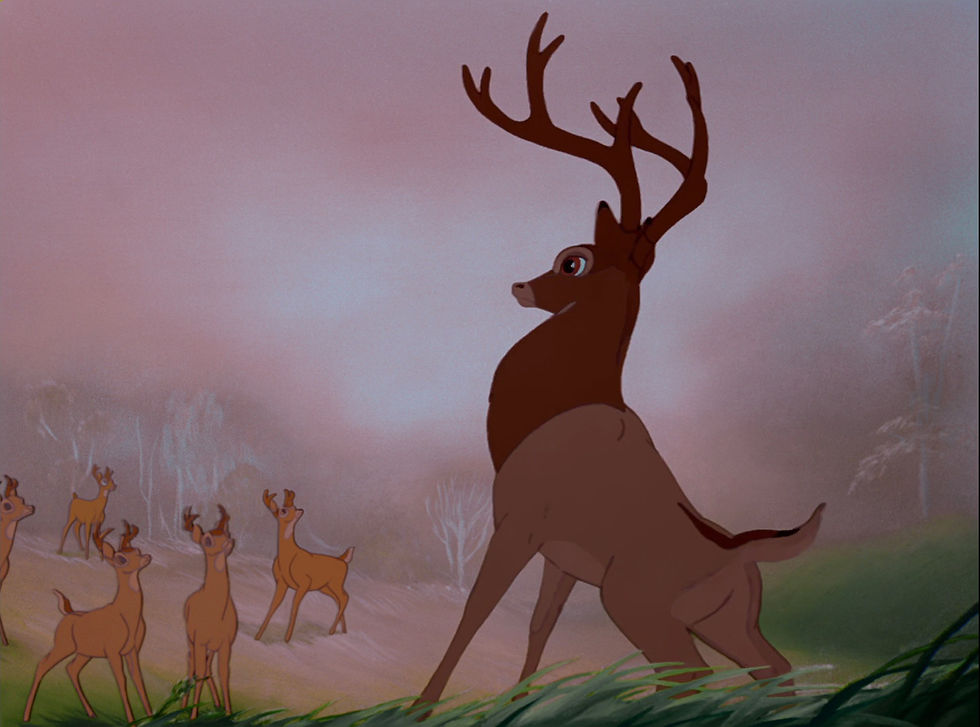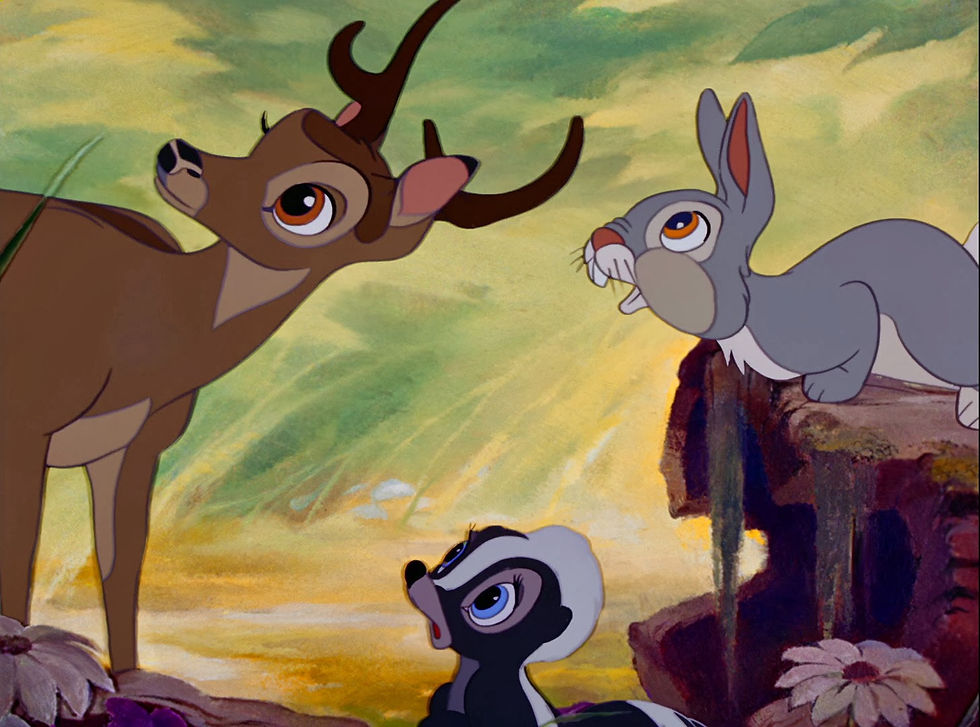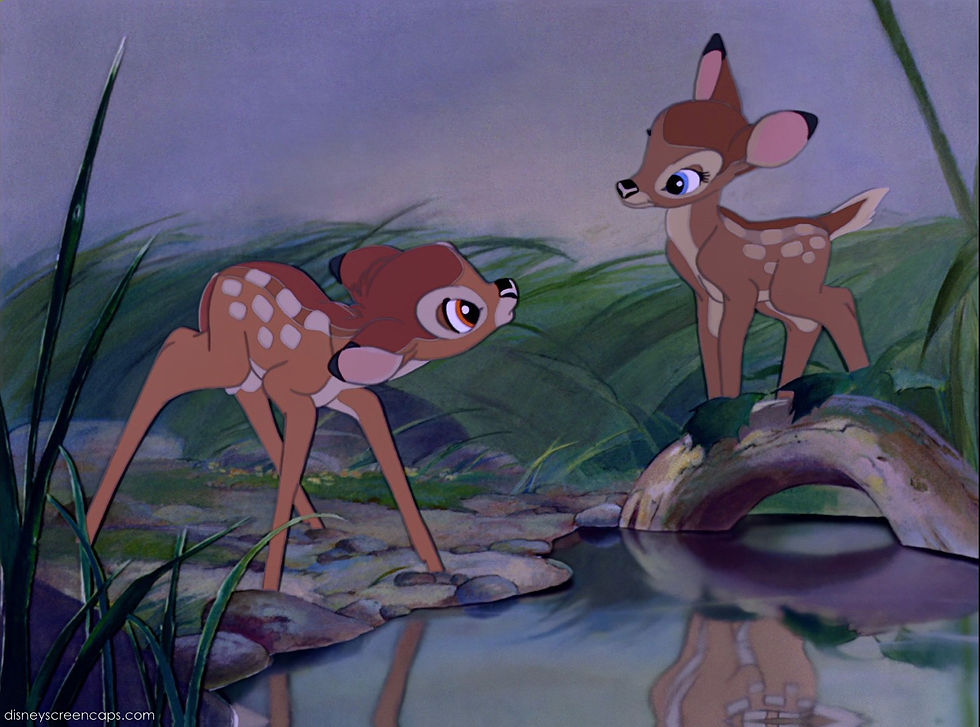Throwback: Bambi
- Laura Slinger

- Dec 3, 2017
- 6 min read

Walt Disney’s Bambi opened on Friday, August 21, 1942 at Radio City Music and was heavily influenced by the making of Snow White, Fantasia, and Pinocchio, borrowing elements from preceding Disney features while pushing animation to a new level of realism and drama. Told more with music and animation than dialogue, the story is a simple one of forest creatures who play and live joyfully even as they fight to survive. At the center of the story is wide-eyed, young fawn named Bambi, growing up in the woods with his mother, who must find a way to endure after hunters tear their family apart. Supported by his friends, Thumper (a rabbit) and Flower (a skunk), Bambi faces the dangers of the forest, woos a delicate doe named Faline, and eventually grows into a strong buck and a leader of the forest.

Many fine artistic choices add grace and elegance to a film that hasn't lost its impact in nearly 70 years. Supervised by Walt Disney himself, the animators closely studied the movement and anatomy of real animals, working for six years to perfect the personalities of the characters and find just the right children's voices for them. No people actually appear in Bambi, but they're instead the unseen menace. Symphonic and choral pieces accompany the animation, which might seem odd to kids today who are used to Disney characters breaking into song-and-dance numbers. Walt was suspicious of artiness - "Weíre selling corn and I like corn," he once said - but he was devoted to pushing into new territories. Fantasia had presented full-blown diabolism with the topless witches and monster devil of the Night On Bald Mountain segment. Bambi, meanwhile, returned to the traditional animal cartoon and twisted it into negative space. The backgrounds took their lead from Tyrus Wong, a lowly Chinese animator whose sketches encouraged other artists to soften and blur the branches and grasses of Bambi's world, putting the focus squarely on the beautifully drawn animals for example Thumper's little-boy mannerisms. Impressionism blends with expressionism in stunning bursts of colour. The forest fire is a shivering yellow painting; the screen brightens to a red-orange as the deer herd flees man; Bambi's fight with a rival stag is all struggling silhouettes, livid golds and icy blues. Using animation as a tool for recreating reality, Mr. Disney's insistence that animal drawings be both realistic and stylized is brilliant. Beginning with Bambi's birth, taking the audience through the death of Bambi's innocence, the adaptation of Felix Salten's novel applies animal anatomy to the art of animation and the result, directed by David Hand, is amazing.

Parents need to know that despite the decades since Bambi's initial release, Walt Disney's animated masterpiece can still be haunting at times for young children. The violence portrayed, unlike in most contemporary animated movies, is realistic, hunters fatally shooting Bambi's mother (off-screen, but still the first thing most viewers remember even decades later), a fire spreading throughout the animals' forest habitat, and Bambi and a fellow buck fighting over a potential mate, it packs an emotional punch. With its mood-shifting color palette and intense sequences of thunderstorms, fires, and angry hunting dogs, this is a more intense movie than parents may remember. As children, we are introduced to the requisite characters who are synonymous with Disney and labeled as “family entertainment” such as Mickey Mouse and Donald Duck, either through television viewings, theatrical releases or VHS/DVD/Blu-ray viewings. The overall general attitude of a Disney film is one of fun and joy, although there are exceptions as some movies, such as Pinocchio (1940) and The Rescuers (1977), have moments that are emotionally dark. Bambi is no traditional Disney movie, and dare I say it’s a film that parents of very young and impressionable children should honestly think twice about before permitting them to view it, as introducing the notion of death to a youngster through a cartoon may prove to be a life-changing event (to say nothing of the constant images of violence that children are subjected to on television and on the Internet each day). After all, this is a Disney cartoon where scene flows to scene with an absolute simplicity, where the terrifying villain never appears, and where the death of Bambi's mother - undoubtedly one of the most traumatic in film history - is restricted to a gunshot, the bleakest of snowscapes and a heartbreaking tear. That Walt can cut from this straight to the silliest of spring-themed symphonies (with twittering bluebirds modelled on a 1933 Disney short, Birds In The Spring) shows his mastery of a medium that can turn on a dime in a way unimaginable in live-action. Very sensitive kids may not be able to handle the death of Bambi's mother, but otherwise, this is a Disney classic -- a direct precursor to The Lion King -- that families can watch together.

Bambi experiences the many things in life that children experience: meeting and taking a liking to new friends (Thumper the rabbit proves a good companion and teacher and a fellow fawn named Faline proves to be a fun female friend) and making honest mistakes (labeling a skunk “Flower” of all things). He is very close to his mother, but does not realize that the Great Prince of the Forest, who protects the animals from Man, specifically hunters, and is both revered and feared by the animals, is his real father. His fortitude is tested when his mother is killed by the hunters and his father reveals his identity to him. Bambi realizes that to survive one must be strong. As the years go by, Bambi matures, grows up and adapts to the environment. He now views the equally older Faline as a potential romantic mate, and wards off a fellow buck, Ronno, who competes for her affections. His childhood friends also find their own romantic mates, and Bambi and Faline are blessed with twins as Bambi becomes the new Great Prince of the Forest.

Essentially Bambi is a one-off, something the studio seems to have forgotten with plugs for a bland-looking video sequel on the otherwise excellent Collector's Edition DVD. It underlines how much Disney has lost since its glorious best-and-worst of times, six decades ago. We laugh and we grieve, but mostly we marvel, at Bambi's introduction to a little April shower, to the miracles of snow and ice, and to the magnificent herd that represents the mystery of adulthood, bounding over Bambi's head with the clash of cymbals. Disney's point, admirably unspoken but transparent to a child, is that this is all of a piece.

Easter Eggs
#1 Based on a book
The novel, Bambi: A Life in the Woods was intended for adults, not children. If audiences thought the death of Bambi’s mother was a bit harsh, they obviously hadn’t reviewed the source material: Among other things, Bambi’s father shows him the corpse of a man who had been shot by his fellow hunter to show that humans weren’t immortal. Felix Salten sold the American film rights to director Sidney Franklin for a mere $1000. Franklin, in turn, sold it to Disney, writing to him, “I would want it to be one of the greatest things ever attempted and done.” Disney paid homage to Franklin in the credits:

#2 Accuracy in animation
To make the animals in the film appear more realistic and lifelike, animators visited the Los Angeles Zoo and Walt Disney set up a small zoo at the studio with animals such as rabbits, ducks, owls, and skunks. They even got up close and personal with two deer donated to the studio, a pair of fawns named Bambi and Faline so that the artists could see first-hand the movement of these animals. But animators really showed their dedication to the craft when they observed a deer corpse in various stages of decomposition for several evenings to see how the muscles and tendons really worked. “Unfortunately, each time he contracted or extended any part of the cadaver a rich aroma was pumped into the air,” animators Frank Thomas and Ollie Johnston recalled.

#3 Recycling frames
Over the years, Disney has often employed an animation technique called “rotoscoping,” where animators trace over the frames of old footage to use it in a different environment. Many Disney films after Bambi used its beautiful frames for example The Jungle Book.

#4 Paul McCartney
Legendary singer-songwriter and ex Beatle Paul McCartney credits the shooting death of Bambi's mother for his interest in animal rights.

#5 Walt's daughter protested
When Diane Disney complained about the needless death, her dad explained that he was just following the book. She proceeded to point out other instances where his movies had veered off from the original material, and besides, she said, he was Walt Disney and could take whatever liberties he liked.









Comments